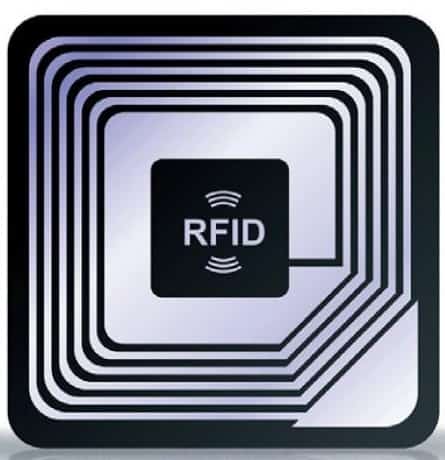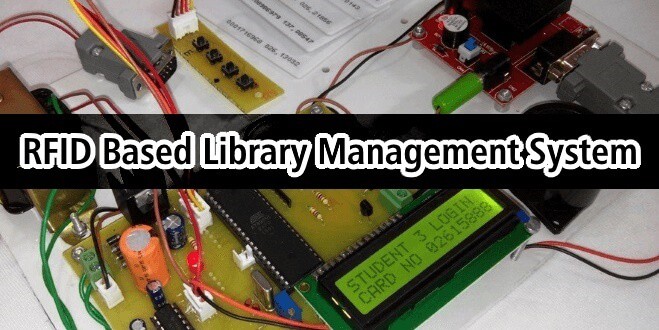An Overview of RFID Based Library Management System
Documentation of RFID Based Library Management System
Introduction to RFID
RFID stands for Radio Frequency Identification, a RF technology based identification system which enables identifying objects using the tags attached to them, irrespective of them being in the line of sight of the reader or not.
RFID System Components
There are two basic components in an RFID system apart from the control system unit, as given below
RFID Tags:
Figure 1: RFID Tag
An RFID Tag consists of a Silicon microchip, attached to a small antenna and both mounted on a substrate, which is encapsulated in different materials like plastic or glass veil. The Tag consists of an adhesive on its back side which enables easy attachment to objects.
RFID Reader:

An RFID reader is a network operated device which acts as an interface between the RFID tag and the system software utilizing data from the tag. It consists of an RF transceiver module along with antennas to transmit and receive information. It basically interrogates RFID tags irrespective of the distance from them.
- Also read : What is ZigBee Technology and How it works?
Types of RFID System
There are two types of RFID systems
1.Active RFID Systems: These systems consist of RFID tags with their own power source (external power supply or battery) and can be used for non-line of sight applications like tracking moving vehicles.
Click image to enlarge
Figure 3: Active RFID vs Passive RFID System
2. Passive RFID system: These are used for line of sight, short range applications where the RFID tags are powered through transfer of power from reader antenna to tag antenna.
Idea about RFID Based Library System
Here I am presenting a brief idea about how RFID based library system would operate. Conventional procedure in libraries involve manually handling functions like keeping record of the books (or magazines, journals etc.) being read at the place, or being given to the reader for a stipulated time-period, checking membership authenticity of existing readers, creating new memberships etc.
These functions are usually done by a person who manually enters new data or modifies existing data in the software, making it tedious as well as time consuming. Hence a more convenient method would be a system where automatic handling of all these operations would be successful. One of the feasible methods is using Radio Frequency Identification System.
This would require each member to possess an RFID card whose chip would contain the person’s contact details, a unique identification code and details of the book (or journal, magazines etc.) in possession of that member.For any new entry, the system would require creation of membership, which would then allow the person to utilize the library amenities.
The identification code of the person would also provide him the authority to enter the library premises. Each item (read books, journals, magazines etc.) in the library would also contain a RFID tag with a unique code embedded in it. Each rack of the library would consist of a small embedded system comprising of a RFID reader, a microcontroller i.e. 8051 and a communication device i.e Max – 232 which exchange the TTL/CMOS logic to RS232 logic levels through the serial communication of Microcontroller with the personal computers.
Data from both the person’s RFID tag and from the book would be scanned by the RFID reader, which in turn communicates with the microcontroller. The microcontroller processes the acquired data and then sends the output data to the main computer for storing information in the database.
Working & Block Diagrams of RFID Based Library Management System
This system would comprise of three sections – The main database section, the individual rack section and the entry section. The first section is the small embedded system installed at each rack of the library, second one consists of the personal computer consisting of the master database.
Given below is the block diagram of the entry section

Once verified, the microcontroller would control the entry motor to open the door and simultaneously display instructions for the person to enter the book name or subject name he is searching for. As the person enters the book details (name or subject name), the microcontroller would send information to the main database section. If book is available, the required rack number would be displayed on the LCD. If not available, similar message would be displayed.
Given below is the block diagram of the individual rack section

- Temporary Reading
- Issuing the book
- Returning the book
- Reissuing the book
If member chooses option ‘a’, he/she can keep the book with himself if he is inside the library. However, if he accidently or deliberately tries to exit along with the book, a system generated warning SMS would be sent to his number along with blocking his exit.
If member chooses option ‘b’, the microcontroller first verifies if the member has reached the limit for number of books issued. If ‘yes’, it would give instructions to the member for choosing option ‘c’. Else, it would send the member’s code along with the book’s code to the main databasesection for adding the book’s details to the member’s database.
If member chooses option ‘c’, the microcontroller would ask the member if he wants to return book or choose option ‘d’. If ‘yes’, the system would delete the book’s details from the member’s database. If option ‘d’ is chosen, member’s database would be re-updated with the book’s details along with the new allotted period.
Given below is block diagram of the main database section

The master database consists of sub databases for each member. Depending upon the option chosen (out of the four options mentioned in the above section), the microcontroller would add or delete the book’s details to his (the member’s) database. Apart from this, the microcontroller would also keep a tab on each person entering and exiting the place.
For instance, if a person choses to temporarily read the book and then tries to exit the library with the book, the microcontroller would send an SMS to the person for keeping the book back into its place, simultaneously re-transmitting instructions to the microcontroller at the entry section for controlling the door opening.
Applications, Pro & Cons of of RFID Based Library Management System
Advantages
- It would be a highly secured and authenticated system.
- Time consumption would lessen as the system is fully automatic.
- It would be an easy and convenient system.
Disadvantages
- With increasing number of racks, it would be difficult to sustain the cost of installation of an embedded system at each rack.
- As this system is completely automatic and does not require human control, it may be subjected to software failures at times.
You may also read:
- Internet of Things (IOT) and Its Applications in Electrical Power Industry
- How To Design a PCB (Step by Step & Pictorial Views)
- Clap Switch Circuit Electronic Project Using 555 Timer











This is what I need to read on the RFID tag. Thanks.